Hack:
OpenStrategies - better leadership through easier leadership
Improve leadership by making strategic leadership easier.
The OpenStrategies’ strategic information platform enables ‘open strategising’ which:
- engages stakeholders in collaborative strategy development, validation and implementation
- succinctly informs all stakeholders exactly what needs to be done and why
- thereby reduces demands on strategic and operational leaders
MIX - Leadership Everywhere Challenge
It is alarming how, in many organisations, few people are clear about what they are supposed to be doing, why they are doing it and how it contributes to the organisation’s strategy. To compensate for this lack of clarity, strong and effective leadership is required.
Alternatively, when people clearly understand what they are supposed to be doing, why they are doing it and how it fits into an organisation’s strategy then they require less leadership.
An effective strategy-development, strategy-validation and strategy-implementation platform is required to fully engage and inform all stakeholders so that there is less need for outstanding leadership. Such a system will “build a leadership advantage” by providing “an organizational model that gives everyone the chance to lead”.
It will do this by “redistributing power in a way that gives many more individuals the opportunity to lead” and by “equipping and energizing individuals to lead even when they lack formal authority (or training)”.
OpenStrategies is such a strategy platform.
MIX - Leadership Everywhere Challenge
Reading note: the images might be easier to review in the .pdf format - see Materials [Document A]
Meeting the challenge
We propose an approach to emergent and evolving syndicated leadership in organisations in a manner which parallels the open source approach to software development with its inherent emergence and evolution of leaders, rather than the conscious development of syndicated leadership.
Why do we need more and better leaders? Because leaders guide what organisations actually do. This can be summarized as:
“Organisations create assets (products, services, and infrastructure) and enable people (customers, citizens) to use them to create benefits”
So the ultimate purpose of having more/better leaders is to improve the way organisations create assets and enable people to use them. Leadership in and of itself should not be the goal. The goal is for effective leadership to improve the way organisations do things.
To improve the way organisations do things using ‘leadership’, two options exist:
- Get or train more/better leaders
- Make it easier for people in organizations to lead using existing, or moderately improved, leadership skills
Option one of up-skilling many people to become better leaders is a daunting task.
Is it possible, instead of or as well as improving leadership skills, to make it easier for people in organizations to successfully lead using their existing, or moderately improved, leadership skills? Can we empower prospective leaders so that they emerge and evolve in self-identifying leadership syndicates with minimal requirements for enhanced leadership skills? Can we empower leaders and syndicates of leaders to be effective from start to finish of the complete business sequence from market research and developing strategies through to implementing the strategies and performance managing their areas of responsibility? Can we make sure that leadership continues to be effective in the long term and is not just a short term effect immediately following leadership training?
We believe that the answer to all these questions is “yes!”
An informative parallel here is the emergence and evolution of leaders, and clusters or syndicates of leaders, in the development of open source software by widely distributed programmers with minimal initial leadership skills in the traditional sense.
Instead of explicitly training leaders, the open source community uses a well-defined system of standards and rules that enable good programmers to create exciting software that other programmers can support. Good programmers with good ideas emerge and meritocratically ’earn the right to lead’ their projects. They don’t achieve leadership through leadership training or by a conscious and deliberate syndication of leadership. They 'earn the right to lead' (see the soon-to-be-published OpenStrategies' book) through their effectiveness in what they do and in how they attract and lead followers. This includes their abilities to plan and write software as well as their effectiveness in connecting with and leading other programmers so that their software interconnects and builds into a greater whole.
Syndicated leadership emerges and evolves naturally without formal leadership training and without imposed leadership syndication. Certainly there will be advantages if some leadership training is also applied, but the key point here is that in the open source software environment, leadership is an emergent function which is made easier through the systematic way that the development of open source software is led.
We propose an approach to emergent and evolving syndicated leadership in organisations in a manner which parallels the open source approach to software development with its inherent emergence and evolution of leaders, rather than the conscious development of syndicated leadership.
In our model, as with the open source model, instead of focusing primarily on training leaders, we use a succinct system of standards and rules that enable reasonably good managers/leaders/operators to create and implement effective strategies (at all levels) and interface them with all other organisational strategies. Good individuals with good ideas emerge and meritocratically 'earn the right to lead' (as distinct from 'take control') of their projects through emergent and evolving syndicated leadership.
In the open source model, the emergence and evolution of software is in a chicken-and-egg relationship with the emergence and evolution of leaders in that each follows the other iteratively.
Likewise, in organisations, the emergence and evolution of strategies, their implementation and performance management is in a chicken-and-egg relationship with the emergence and evolution of leaders in that each follows the other iteratively.
This means that an effective platform for the syndicated emergence and evolution of strategies at all levels will underpin the syndicated emergence and evolution of leadership at all levels which will in turn underpin the syndicated implementation and performance management of those strategies by those distributed but inter-connected leaders.
A principle component of the open source model is a common system of communications and ‘open standards’ which enable all participants, their ideas and their software to inter-relate while requiring minimal leadership skills. The OpenStrategies’ platform provides such a common strategy platform (strategy taxonomy, syntax and semantics) which enable strategies, and consequently their leaders at all levels, to inter-relate ie to 'syndicate' in an emergent and evolving manner.
This does not require the widespread up-skilling of people to become leaders. If people use a continuously evolving strategy development platform which makes it explicitly clear exactly what needs to be done and why at all levels in the organisation, then people are able to do their jobs effectively with reduced requirements for ‘leaders’.
The OpenStrategies’ model of syndicated strategy development and implementation works like this.
As noted above:
“Organisations create assets (products, services, and infrastructure) and enable people (customers, citizens) to use them to create benefits”
Put another way:
“Organisations run Projects that produce Results which communities and citizens Use to create Benefits” (PRUB)
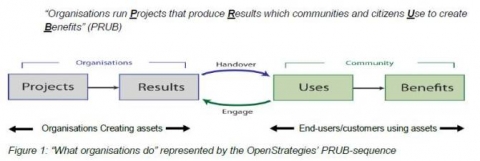
Figure 1: 'What organisations do' as represented by the OpenStrategies’ PRUB-sequence
Everything else that happens in an organisation (finance, HR, safety) is peripheral to this core function. Therefore organisational strategies, their implementation, their performance management and their respective leaders should all be focused on improving the effectiveness and efficiency of the above sequence. This needs to happen at a high level to produce an overarching organizational strategy as well as at operational levels (where such strategies are often known as action plans - but they are still strategies) and at every level in between.
Leaders, individually and in evolving syndicates, need to lead the above sequence.
In the OpenStrategies’ taxonomy, ‘Results’ consist of infrastructure and services and are often known as ‘outputs’. ‘Benefits’ are defined by the ‘four wellbeings’ (economic, social, environmental and cultural) and are often known as ‘outcomes’.
Every single strategic idea can be encapsulated in this simple PRUB sequence (www.openstrategies.com) irrespective of whether it is a high level aspirational sequence like the following 'SubStrategy' or an operational SubStrategy like the subsequent example.
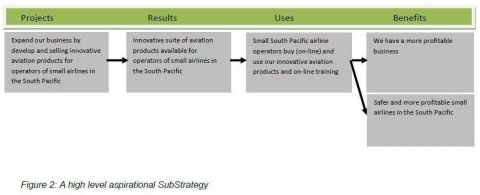
Figure 2: A high level aspirational SubStrategy
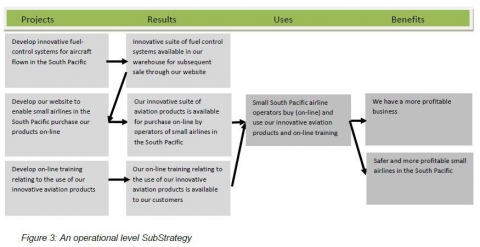
Figure 3: An operational level SubStrategy
If each level in an organisation has an evolving SubStrategy like this which is exactly specific to their areas of activities then there is less need for highly skilled leadership than if this information isn’t readily available.
As shown in the next diagram, the above operational-level SubStrategy is intimately linked to the previous higher level SubStrategy, thereby also ‘vertically linking’ senior-leaders with operational-leaders into a ‘vertical syndicate’.
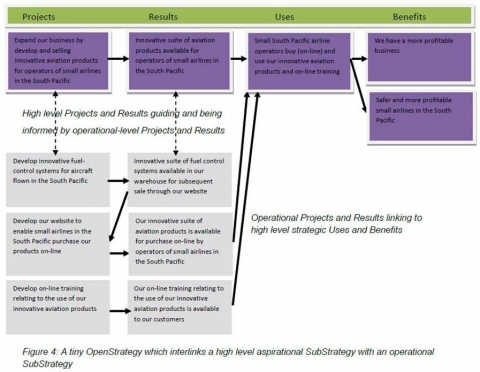
Figure 4: A tiny OpenStrategy which interlinks a high level aspirational SubStrategy with an operational SubStrategy
Similarly each of the operational-level activities is interlinked to the other operational-level activities, thereby simultaneously ‘horizontally linking’ operational leaders into an operational-level ‘horizontal syndicate’. In most circumstances it is likely that mixed vertical and horizontal ‘strategy-syndicates’ and their accompanying ‘leaders-syndicates’ will emerge and evolve.
As an example, in the public sector a local authority’s community strategy (and its associated real-world actions led by leaders) is likely to contain a number of high-level aspirational SubStrategies relating to the overall well-being of the community it serves. At an operational level it will probably have SubStrategies on transport, housing, health, safety, recreation, the environment and many other topics. Many of these operational SubStrategies will link with each other, so for example a transport strategy will invariably overlap with a safety strategy which will overlap with an older persons’ strategy which may overlap with a recreational strategy.
Similarly in companies, a marketing strategy will invariably overlap with a product development strategy and both will overlap with or inter-link with a production strategy.
These overlaps and inter-links across organisations and themes mean that the respective leaders of sub-groups and themes need to form evolving syndicates of leaders to enable collaborative working across organisational and thematic boundaries.
Using the OpenStrategies’ platform, every leader always knows exactly what their own SubStrategy or action plan is, how it contributes to the organisation’s overarching high level SubStrategy and how it overlaps or links with all other operational or mid-level SubStrategies. This interlinking similarly applies to the leaders of each SubStrategy to create an evolving mix of leadership-syndicates to collaboratively guide the implementation of the inter-linked SubStrategy-syndicates or clusters.
A key principle here is that to enable SubStrategies and their leaders to be interlinked (syndicated) so that they work effectively throughout an organisation, every strategic idea within an organisation must use this same simple strategy language and format. This form of 'leader-and-SubStrategy-syndication' reduces the intensity of demands for advanced leadership skills.
So the OpenStrategies’ platform enables high-level executives to work with their own high-level aspirational strategies, mid-level managers to work with their mid-level strategies and operational level people to work with their operational-level – with all the different levels of strategy interlinked with each other. In each case, leadership is simplified and cross-linked – ie leadership syndication emerges and evolves in order to address emerging and evolving cross-linked (syndicated) strategies.
In the above simplified example SubStrategies, the levels of strategies are linked and as a consequence the levels of leadership are also linked in two ways:
- Operational-level Projects and Results (and their leaders) are sub-sets of the high level Projects and Results (and their leaders)
- All levels of strategies (and their leaders) share the same Uses and Benefits
So 'SubStrategies' become the core ‘strategic information modules’ which underpin the syndication of both actions and their leaders.
How does this OpenStrategies’ platform cope with the evolution and emergence of ideas at all levels (given that a key role of leaders is to respond effectively to change)? In particular, how does the OpenStrategies’ platform support leaders in times of urgency and crisis?
Imagine all levels of strategies (each with their own ‘leaders’) evolving in-sync with all other levels, each SubStrategy evolving in response to its own needs and co-evolving in response to the evolution in other SubStrategies. Such an evolving suite of SubStrategies would enable local ‘leaders’ to keep improving the way their organisations 'create assets and enable customers/citizens to use them'.
To achieve this we need a strategy platform in which clusters of strategies/plans and their leadership syndicates can emerge and evolve at any level within an organization in response to any and all types of change. In such environments, a high level ‘corporate’ strategy would co-inform and co-evolve with a mid-level ‘management’ strategy and both would co-inform and co-evolve with a suite of operational-level strategies distributed throughout an organization.
In such a system, leaders at all levels would plug into the strategy platform (their organisational 'OpenStrategy') which displays all levels of SubStrategies so they could continuously co-evolve their strategies so as to stay attuned to all other organizational SubStrategies at all levels and across all disciplines. Leadership would be syndicated.
In this way, locally-led actions (based on local SubStrategies) would always be consistent with high level SubStrategies. Executives responsible for higher level SubStrategies could respond to proposed changes in operational-level SubStrategies by accepting/rejecting/editing them and/or modifying the higher level SubStrategies accordingly.
How could such evolution and emergence of new SubStrategies and inter-linked clusters of SubStrategies and their leadership syndicates actually happen?
An effective approach would be to have a current set (an OpenStrategy) of approved SubStrategies (and their associated leadership syndicates) which are being implemented and in parallel to have a set of emerging and evolving SubStrategies which, once they have been refined and validated, can be transferred into the current set of SubStrategies (the OpenStrategy) to become the new way of doing things.
We have determined that just four steps are required to shift an emerging SubStrategy into a 'validated' operational SubStrategy that potentially gets implemented (see the attached 'PRUB-Validate' paper).
Such evolution and validation of strategies can happen in very short time-frames eg in a crisis or emergency because the OpenStrategies’ system simultaneously liberates the collective wisdom of all leaders at all levels by enabling them to rapidly design, share, inter-link and co-evolve new SubStrategies to address immediate concerns.
Therefore, and this is crucially important, all leaders at all levels can contribute to the strategy evolution process, the strategy implementation process and the performance management process, all of which are core leadership roles. They can recommend improvements to their own SubStrategy to improve it in itself, to improve how it contributes to the overarching corporate SubStrategies and to improve how it interfaces with all other SubStrategies at all levels. SubStrategy leaders can also make suggestions to the leaders of all other SubStrategies as to how they might be improved for the overall wellbeing of the organisation and its customers.
So both leadership, and each leader’s SubStrategy, would be interactively syndicated at all levels and these syndicates would constantly evolve in response to the evolution and emergence in the organisation’s overall suite of SubStrategies ie its OpenStrategy. In this system, a key role of leadership will to constantly evolve the development and operation of the leadership syndicates themselves so as to optimize the interactions amongst all of an organisation’s SubStrategies.
Crucial to this entire process is that all levels of strategy must use exactly the same simple strategy language (taxonomy, syntax and semantics).
The OpenStrategies’ platform which is based on the profoundly simple concept of PRUB-based SubStrategies is an effective, perhaps the most effective such strategy language:
“Organisations run Projects that produce Results which communities and citizens Use to create Benefits” (PRUB)
We are confident that PRUB represents: “the smallest amount of strategic information that has the most value to the most stakeholders” throughout an organisation (and its suppliers and customers). Through working with several thousand stakeholders in a range of private and public sector organisations we are confident that all stakeholders readily understand and can work with PRUB-based SubStrategies.
As a brief aside, it is worth noting that irrespective of the complexity of the world, every single action, encapsulated within a SubStrategy, must necessarily be simple (known knowns) even if cumulatively they become a complicated suite of actions (unknown knowns). Actions and SubStrategies cannot be complex (unknown unknowns) or chaotic (unknowables). So SubStrategies can absolutely represent 'what needs to be done and why' (or a “plan and a rationale” as defined by Freek Vermeulen at the London Business School).
How does the OpenStrategies’ platform simplify and empower the roles of those leaders who are responsible for the overall strategic wellbeing of an organization?
- They can develop an overall high-level, aspirational SubStrategy which everyone can see and understand
- They can ask mid-level and operational-level people to develop SubStrategies at their respective levels which will 'deliver the goods' required by the high level SubStrategy
- High-level leaders can then watch the emergence of the operational-level SubStrategies and either redirect them to align them with the high level SubStrategies or, as is likely in many instances, to refine the high level SubStrategies in response to operational level ones
- High level leaders could encourage the formation of leadership syndicates to develop and implement strategies on cross-linked issues
- Because all levels of SubStrategies would constantly be evolving, the above 4 steps would be constantly iterating
How does the OpenStrategies’ platform simplify and empower the roles of those local leaders who are responsible for operational-level strategies?
- Evolving local SubStrategies and local leadership would be guided by, but not totally constrained by, the higher level SubStrategies
- The local leaders could demonstrate how they and their operational SubStrategies are contributing to 'the big picture' aspirational SubStrategies of the organisation
- Local leaders would be able to engage objectively with higher level managers whenever they believed that the higher level SubStrategies needed to evolve to respond to operational-level innovations or market forces
- Local leaders would be able to form syndicates to develop and implement cross-linked strategies
- Local leaders would be able to share with their teams exactly what each team needs to do (their operational-level Projects and Results) and how these contribute to the corporate actions (the high level Projects and Results) and the overall objectives of the organization (the high level Uses and Benefits)
So in summary, how does the OpenStrategies’ approach address the following MIX challenges:
- First, you have to redistribute power in a way that gives many more individuals the opportunity to lead
- Second, you have to equip and energize individuals to lead even when they lack formal authority?
Answers:
- OpenStrategies provides a robust strategy development platform to transparently empower leadership at all levels – and in doing so, it 'redistributes power' to all leaders
- OpenStrategies provides a logical information structure for ‘syndicating’ (joining together) SubStrategies and as a consequence it simultaneously helps to syndicate leaders
- Using the OpenStrategies’ platform, syndication of leadership and SubStrategies are both emergent and evolutionary and, most importantly, they evolve/emerge in-sync with each other
- when individuals are equipped to know exactly what they are doing, why they are doing it and how it interlinks with all other organizational actions (as defined in an organisation’s multi-level suite of SubStrategies), they become more energized and focused and leadership becomes easier
So the OpenStrategies’ platform directly addresses the MIX challenges.
Additional Information:
- “PRUB-Validate Public Sector Investments” (note that this applies to any investments whether public, private or third sector) is in 'Materials [Document B]'
OpenStrategies - Benefits and Impact
So at a general level, the OpenStrategies’ platform does directly address the MIX challenges.
Let’s now look in some detail at how the OpenStrategies’ approach addresses the “leverage points” identified in the MIX Leadership Everywhere Challenge.
These leverage points are listed in the first column in the following table. Column two describes how the OpenStrategies’ approach addresses every one of these leverage points.
Readers’ attention is particularly drawn to the way OpenStrategies addresses leverage point #9 in the table – the concept of an international library of proven SubStrategies which are made available to leaders throughout the world to make their leadership roles simpler and more effective.
Table 1: MIX Leadership Everywhere “leverage points” and how OpenStrategies addresses them
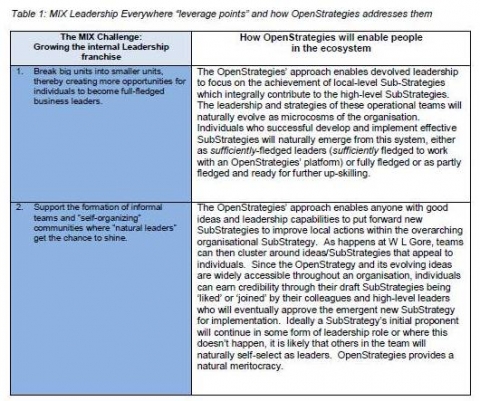
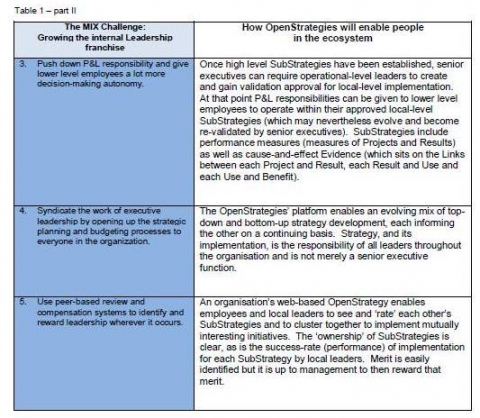
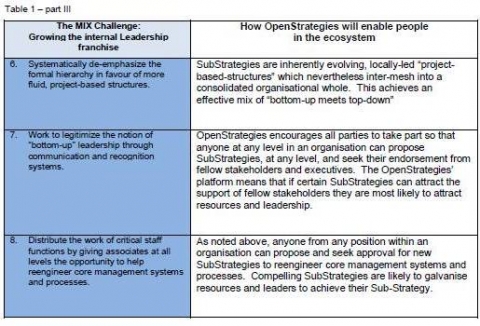
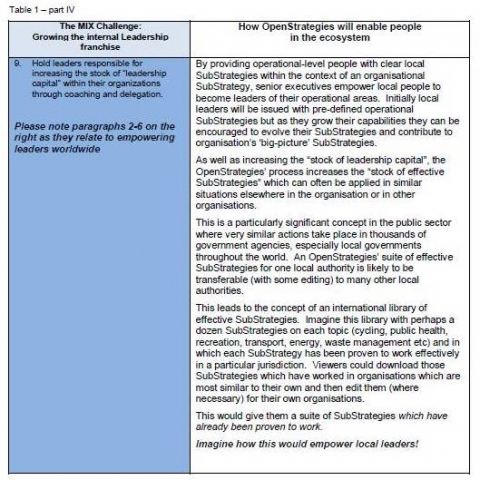
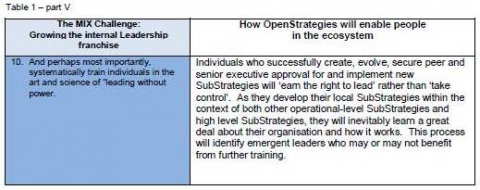
In this section we briefly outline how to adopt the principles of OpenStrategies using the PRUB approach to create and Validate a Sub-Strategy as described in the attached paper 'PRUB-Validate Public Sector Investments' see Materials [B].
The best place to start is to develop a precise understanding of 'Uses' ie exactly what to users want to be ‘doing’. Once you understand what users (customers, citizens) want to be doing it becomes relatively straightforward to determine what ‘Results’ (assets such as services, products and infrastructure) they want and hence what ‘Projects’ are required to produce those Results.
It is far more informative to ask users “what do you want to do?” than to ask them “what do you want?”. Here’s a classic example. If you ask city people “what do you want?” many of them will reply “we want more cycle-lanes”. However if you ask these same people “what do you want to do?” many of them will admit that “I want to drive my car in the city because there is less congestion because more other people are cycling”. So the real issue here is people’s frustration with congestion and more cycle-lanes are probably not the best solution.
So it is imperative to start by explicitly understanding Uses and to then use this information to define the right Results which will enable these Uses. So step one is to engage with Users to exactly understand their desired Uses and to use this information to define the desired Results and hence the necessary Projects. Users will also be a good source of information explaining why they are wanting their Uses and the answers to this ‘why’ question will define the Benefits.
Typically it will require a number of parallel Projects to produce a set of Results to enable a Use. For example, it might require four Projects to: build a swimming pool, train lifeguards, provide a bus service to the pool and provide water-fun programmes in order to effectively enable a Use of ‘children come and play in the pool’ which in turn creates the Benefit ‘children are healthier’.
Ideally the development of a strategy works from right-to-left (BURP) and the implementation of a strategy works from left to right (PRUB). So a strategy using this format is simultaneously a strategy (BURP) and an implementation plan (PRUB).
Once strategic actions are defined as SubStrategies and clustered into OpenStrategies all stakeholders (customers, citizens, communities, employees, organisations and others) can easily see:
1. what needs doing
2. why it’s being done
3. how operational-level actions contribute to the organisation’s high level strategy
4. how each operational-level action on a particular theme inter-links with other
operational actions on other themes
However, the SubStrategy is purely theoretical at this stage. It is now necessary to ‘validate’ it by:
1. adding convincing ‘cause-and-effect Evidence’ to the Links between Projects
and Results, between Results and Uses and between Uses and Benefits
2. by convincingly determining that the net ‘value’ of the Benefits is greater
than the total costs of the Projects plus the costs of the Uses
When a strategic idea has been translated into a SubStrategy and then validated with convincing cause-and-effect Evidence plus net value information it is said to be ‘PRUB-Validated’. Every SubStrategy within an overall organisational OpenStrategy must be PRUB-Validated if the overall strategy is to be valid.
When stakeholders have direct access to their organisation’s suite of PRUB-Validated SubStrategies (ie their OpenStrategy) then they can cluster together and ‘get on with their SubStrategies’ while requiring minimal leadership. Where necessary for coordination across multiple SubStrategies, syndicates of leaders naturally emerge to lead cross-functional activities.
In the competitive market place those who able to adopt the OpenStrategies’ approach will have a competitive advantage: clarity of purpose, engaged citizens and customers, better strategies, better implementation of strategies and easier but more effective leadership.
This document was jointly prepared by Dr Phil Driver in New Zealand and Ian Richardson in the UK.
Dr Phil Driver Ian Richardson
OpenStrategies Ltd ian2richardson@gmail.com
phil@openstrategies.com Skype ian2richardson
Phone +64 (0)3 337 6641
Mobile +64 (0)21 0236 5861
Skype philosldriver

Materials, see the links under the Documents heading below:
[Document A] This document is the OpenStrategies' MIX submission
in .pdf format. Some viewers might find the figures and
tables easier to read in this format.
[Document B] This contains additional Information to [A] and illustrates how
projects are validated in the OpenStrategies approach
'PRUB-Validate Public Sector Investments'.
PRUB-Validate explicity determines:
- which investments are 'validated' and should be retained
- which investments cannot be 'validated' and should be
modified or terminated
[Document C] This is a composite document with [A] and [B] combined and
the addition of the primary MIX Moonshots
Websites

liberating collective wisdom
In the 1990’s Margaret Wheatley author of Leadership and the New Science -
Margaret Wheatley’s challenge:
“I am not alone in wondering why organisations aren’t working well. Why do so many organisations feel lifeless? Why do projects take so long, develop ever greater complexity, yet too often fail to achieve any truly significant results?”
Implied that our search will result in . . .
“To my mind there must be, at the bottom of it all, not an equation, but on utterly simple idea. And to me that idea, when we finally discover it, will be so compelling, so inevitable, that we will say to one another, “Oh, how beautiful. How could it have been otherwise?”
John Archibald Wheeler
Video (2 minutes)
What is your utterly simple idea?
- Log in to post comments
This brings to life Peter Senge's definition of leadership 'the capacity of a human community to shape its future'.
See the two minute video http://www.youtube.com/watch?v=68unIDHgWhY
- Log in to post comments




You need to register in order to submit a comment.